How the Younger Dryas Might Happen Again
two: What scientific prove do we have that abrupt climatic change has happened earlier?
Evidence of abrupt climate alter comes from all manners of sources (glacial deposits, tropical and polar water ice caps, pollens, lake and marine sediments, tree rings, corals, speleothems, etc). Confidence in identifying such changes rises when more than 1 information source, and in more than ane region, records the consequence. Many abrupt changes can be readily identified since the meridian of the last ice age, but let us consider 2 examples with very different causes and consequences.
1. The Younger Dryas
What is the Younger Dryas?
An event that occurred well-nigh 12,800 years before present (BP), termed the Younger Dryas (YD), is the canonical example of abrupt climate change. It is best seen in the Greenland ice cores, although it had very marked consequences over Europe, North America, and every bit far as New Zealand. The YD is an invaluable example written report: it occurred recently enough then that records of it are well-preserved, and seems to have left traces all over the globe.
Permit us look at the temperature over Greenland for the last eighteen,000 years:
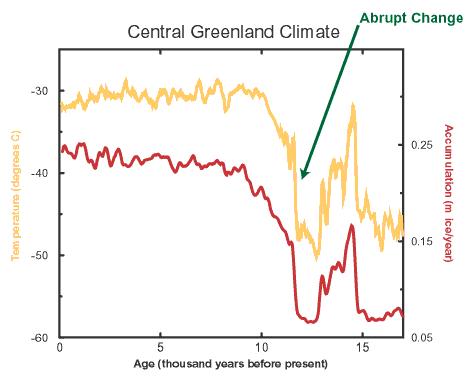
Figure 1: The Younger Dryas event as an example of abrupt climate change. Source: Abrupt Climate Change; Inevitable Surprises
Around 15,000 years ago, the Earth started warming abruptly after ~ 100,000 years of an "ice age"; this is known equally a glacial termination. The large water ice sheets, which covered pregnant parts of North America and Europe, began melting as a event. A climatic optimum known every bit the "Bölling-Allerød" was reached shortly thereafter, around 14,700 before present. Notwithstanding, starting at nearly 12,800 BP, the World returned very quickly into nearly glacial conditions (i.eastward. cold, dry out and windy), and stayed in that location for about 1,200 years: this is known as the Younger Dryas (YD), since it is the most recent interval where a plant characteristic of cold climates, Dryas Octopetala, was plant in Scandinavia.
The most spectacular aspect of the YD is that information technology ended extremely abruptly (effectually 11,600 years ago), and although the date cannot exist known exactly, it is estimated from the annually-banded Greenland ice-core that the annual-mean temperature increased by as much as ten°C in 10 years.
Why was there a Younger Dryas?
This is a touchy subject that is currently the focus of much research. One explanation is the i involving a thermohaline circulation (THC) shutdown, triggered past a catastrophic belch of freshwater from Lake Agassiz (figure 2). The consequence is a rapid reduction in north body of water rut transports, leading to an abrupt cooling over Northern Europe and Due north America. That is why and then much attention is focused on the behavior of the N Atlantic sea circulation: non simply past scientists, only also Hollywood screenplay writers. Bear in mind, withal, that the greenhouse world we are creating through fossil fuel burning might not behave at all similar the Earth of 12,800 years ago, then that this scenario may be irrelevant for future climate change.
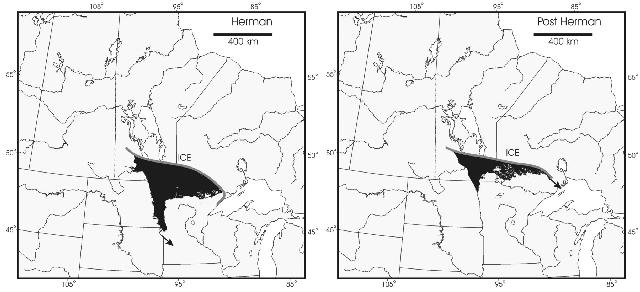
Figure ii: (Left) The outline of Lake Agassiz just before the catastrophic flood. At that fourth dimension its outlet was to the south into the Mississippi drainage. (Correct) The outline after the opening of the east outlet. A volume of 9500 cubic kilometers of water was suddenly released to the northern Atlantic through the St. Lawrence Valley (Leverington et al. 2000). (Source: Broecker, 2003)
A trouble with this hypothesis is the timing of meltwater pulses that are supposed to have triggered the THC shutdown: it was found that a 2nd meltwater pulse, albeit slightly smaller than the first one, occurred at the cease of the YD (Fairbanks, 1989): why didn't it also trigger a similar chain of consequences in the climate system?
An alternating explanation (Cloudless et al., 2001) invokes the abrupt cessation in the El Nino -Southern Oscillation in response to changes in the orbital parameters of the Earth, although how such a modify would touch on regions away from the Tropics remains to be explained.
The respective merits of both hypotheses have been laid out by Broecker (2003). The issue is far from beingness settled, and actively researched at Lamont and elsewhere.
Were at that place any other events similar this one?
There are many other examples of abrupt climate change in the last 50,000 years, which deport the rather ambiguous names of Heinrich, and Dansgaard/Oeschger events. The moving-picture show below (effigy 2) shows where Dansgaard/Oeschger (DO) events accept been recorded. More details on those are provided on this link.
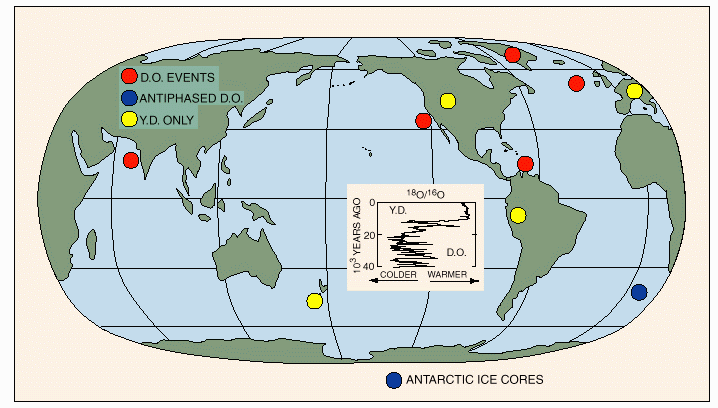
Figure 3: Locations of the main records of sharp climate modify in the last 40,000 years. The inserted curve is a proxy for the temperature of precipitated snowfall over Greenland. (Source: Wallace Broecker)
From this inserted panel, information technology is clear that the YD was a very potent consequence, notwithstanding information technology is also apparent that it was only the most recent of a series of big and precipitous climate swings that occurred repeatedly in the last ice historic period, and were recorded in many places around the earth, as attested by the number of reddish dots on the picture.
Although they are of considerable theoretical involvement, all these oscillations (including the YD) occurred at a fourth dimension when parts of the Northern Hemisphere continents were covered by ice sheets, and the subpolar oceans where covered by body of water-water ice in winter. This makes such cases less relevant for understanding what might happen to our greenhouse world every bit a result of human activities. A better analog would be the Late Paleocene Thermal Maximum (about 55 million years ago, when the World was very warm), but the information about this period is frustratingly sparse considering it is and then remote in time. Allow us so switch to another, more contempo, and socially dramatic example:
two. The Akkadian collapse (Mesopotamia, 4200 agenda year B.P.)
Under the rule of Sargon of Akkad, the showtime empire was established betwixt about 4300 and 4200 agenda years before present (B.P). on the broad, flat alluvial obviously between the Tigris and Euphrates Rivers (Weiss et al., 1993). Akkadian imperialization of the region linked the productive but remote rain-fed agricultural lands of northern Mesopotamia with the irrigation agriculture tracts of southern Mesopotamian cities. After nigh a hundred years of prosperity, even so, the Akkadian empire collapsed abruptly at 4170 ± 150 agenda yr B.P. (Weiss et al., 1993; Postgate, 1992). Archaeological evidence documents widespread abandonment of the agricultural plains of northern Mesopotamia (Weiss et al., 1993) and dramatic influxes of refugees into southern Mesopotamia, where populations swelled (Weiss et al., 1993, Weiss, 2000). A 180-km-long wall, the "Repeller of the Amorites," was built beyond central Mesopotamia to stem nomadic incursions to the due south. Resettlement of the northern plains by smaller, sedentary populations occurred near 3900 agenda yr B.P. , about 300 years after the collapse. The stratigraphic level representing the collapse at Tell Leilan, northeast Syrian arab republic, is overlain past a meter-thick accumulation of current of air-blown fine sediments, suggesting a sudden shift to more arid conditions. Social collapse plainly occurred despite archaeological testify that the Akkadians had implemented grain storage and h2o regulation technologies to buffer themselves against the big interannual variations in rainfall that narrate this region (Weiss et al., 1993).
Information technology has been recently proposed (Cullen et al. 2000) that the demise of this complex civilization is due to a prolonged menstruum of drought starting at 4025 ±150 years). Paleoclimatic show is given in Figure 4.
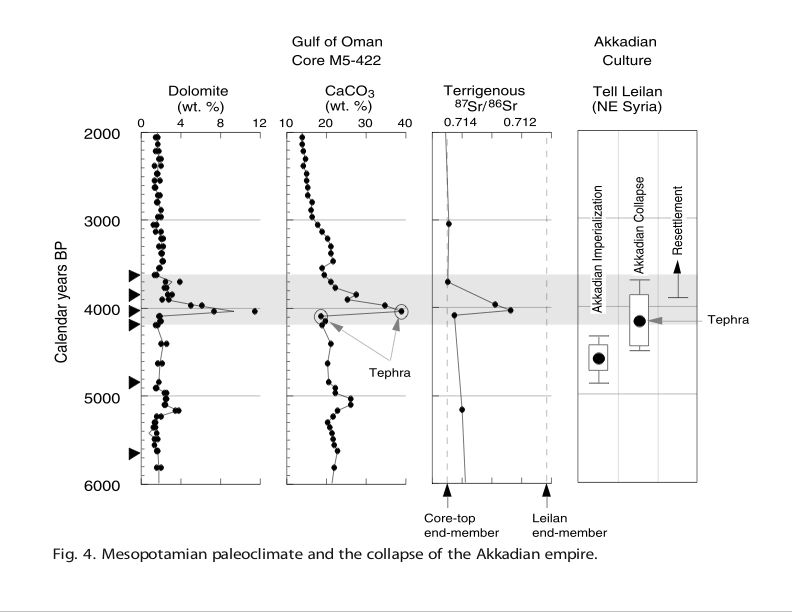
Figure 4: Tardily Holocene record of Mesopotamian aridity every bit reconstructed from the quantity of current of air-borne sediment components in a deep-sea core retrieved in the Gulf of Oman. The shaded grey area highlights a menses spike in wind-blown sediments in the core, dating by radiocarbon methods . For such a high quantity of terrestrial dust to accept been uplifted from Mesopotamia and transported to the sea, it is inferred that a drought persisted for about 300 years. (Source: deMenocal, 2001)
Geochemical similarity of volcanic tephra shards found at Tell Leilan and in the abyssal sediment cadre provided further evidence that the Akkadian collapse and climatic change events were synchronous (Cullen et al, 2000). Enhanced regional aridity is also indicated by increased wind-blown quartz deposition in nearby Lake Van at the headwaters of the Tigris River (Lemcke and Sturm, 1997) and by paleoclimate records from the Levant (Bar-Matthews et al., 1997). The combined archaeological and paleoclimate evidence strongly implicates abrupt climate change equally a key gene leading to the demise of this highly complex social club.
The onset of sudden aridification in Mesopotamia near 4100 calendar yr B.P. coincided with a widespread cooling in the Northward Atlantic (Bail et al., 1997; deMenocal et al., 2000). During this event, termed Holocene Event iii (Fig. 5, below), Atlantic subpolar
and subtropical surface waters cooled by i° to two°C.
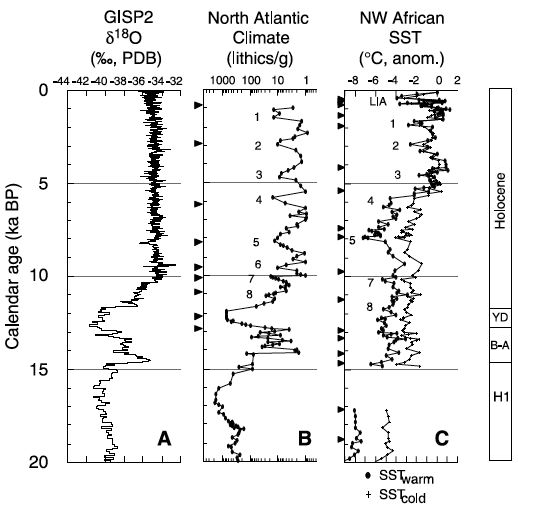
Effigy five: The 4100 drought put it the context of the last 20,000 years.
Console A displays a proxy for the temperature of atmospheric precipitation over Greenland. Console B shows the fraction of lithic grains per gram in the northern Due north Atlantic, which is interpreted every bit a proxy for iceberg belch there. Panel C shows a proxy for the ocean-surface temperature (SST) off N Due west Africa. (Source: deMenocal, 2001)
The headwaters of the Tigris and Euphrates Rivers are fed by elevation-induced capture of winter Mediterranean rainfall. Analysis of the modernistic instrumental tape shows that large (50%) yr-to-year reductions in Mesopotamian water supply result when subpolar northwest Atlantic bounding main surface temperatures are anomalously cool (Cullen and deMenocal, 2000). The aridification of Mesopotamia most 4200 calendar yr B.P. may thus have been related to the onset of libation bounding main surface temperatures in the Northward Atlantic, the ultimate cause of which has not nevertheless been elucidated. Every bit obscure is why similar coolings (1 and 2 in the bend to a higher place) did not trigger similar droughts.
The example of such a "mega-drought" and its dire consequences is particularly revealing of the vulnerability of circuitous societies to abrupt changes in our current climate, often believed to exist much more than stable than that of the "glacial world". From Console A in figure five, i would think that the last xi,000 years have been rather uneventful, and this is quite true in terms of temperature changes in Greenland. Notwithstanding, we run across here that this did non forestall marked, regional changes in precipitation spanning unabridged decades, or fifty-fifty centuries in this case.
To further confirm the modern relevance of such abrupt climate change, we present beneath a map of the estimated extent of the Akkadian empire:
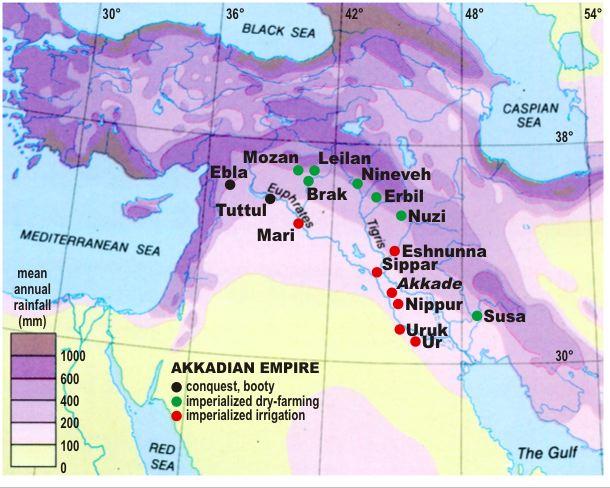
Figure 6: Map of the Akkadian empire (source: http://research.yale.edu/leilan/akkadian/)
A quick comparing to a map of the mod Eye East, reveals that were such a megadrought to occur today over one-time Mesopotamia, which is now a region of exquisite geopolitical sensitivity, information technology would still have profound human consequences on the region. Judging past the history of the last 3 years, it would besides have global strategic consequences.
References
| Bar-Matthews One thousand., A. Ayalon, A. Kaufman, Late 4th Paleoclimate in the Eastern Mediterranean Region from Stable Isotope Assay of Speleothems at Soreq Cavern, State of israel, Quat. Res. 47, 155 (1997) | |
| Bond G, Showers W, Cheseby Chiliad, Lotti R, Almasi P, deMenocal P, Priore P, Cullen H, Hajdas I, Bonani G, A pervasive millennial-scale cycle in Due north Atlantic Holocene and glacial climates, Scientific discipline, 278 (5341): 1257-1266 Nov xiv 1997. | |
| Broecker, WS., Does the trigger for abrupt climate change reside in the oceans or in the atmosphere? Science 300 (5625): 1519-1522 JUN 6 2003. | |
| Clement Air-conditioning, Cane MA, Seager R , An orbitally driven tropical source for abrupt climate change, Journal of Climate, 14 (11): 2369-2Weiss et al., 19935 2001 | |
| Committee on Sharp Climate change, National Research Council, "Abrupt Climatic change: Inevitable Surprises", 244 pages, 2002 | |
| Cullen H. et al, Climatic change and the collapse of the Akkadian empire: Evidence from the deep sea, Geology, 28,Weiss et al., 19939, 2000. | |
| Cullen, H. and P.B. deMenocal, Int. J. Climatol., 20, 853, 2000. | |
| deMenocal, P.B., J. Ortiz, T. Guilderson, and M. Sarnthein, Coherent High- and Depression-Breadth Climate Variability During the Holocene Warm Flow, Science, 288 (2000), 2198-2202, 2000 | |
| deMenocal, P.B., Cultural responses to climatic change during the late Holocene, Science, 292, 667-673, 2001. | |
| Fairbanks RG, A 17,000-twelvemonth glacio-eustatic bounding main-level record - influence of glacial melting rates on the Younger Dryas result and deep-ocean circulation, Nature 342 (6250): 637-642 DEC 7 1989 | |
| Lemcke G., M. Sturm, in Tertiary Millennium B.C. Climate Modify and Sometime World Collapse, N. Dalfes, G. Kukla, H. Weiss, Eds., vol. 49 of NATO ASI Series I (Springer, Berlin, 1997), pp. 653-678. | |
| Postgate, J.N, "Early on Mesopotamia", Routledge, New York, 1992. | |
| Weiss, H, Courty, M.A., Wetterstrom, W., Guichard F., Senior Fifty., Meadow R., Curnow A., The genesis and collapse of 3rd millenium north millenium mesopotamian culture, Science, 261 (5124): 995-1004 AUG 20 1993. | |
| Weiss, H., in "Engaging the Past to Understand the Future", K. Bawden, R. Reycraft, Eds. (Univ. of New Mexico Printing, Albuquerque, 2000), pp. 75-98. |
![]()
Source: https://ocp.ldeo.columbia.edu/res/div/ocp/arch/examples.shtml
0 Response to "How the Younger Dryas Might Happen Again"
Post a Comment